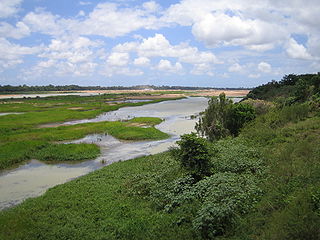
The Burdekin River is a river in North and Far North Queensland, Australia. The river rises on the northern slopes of Boulder Mountain at Valley of Lagoons, part of the western slope of the Seaview Range, and flows into the Coral Sea at Upstart Bay over 200 kilometres (124 mi) to the southeast of the source, with a catchment area of approximately 130,000 square kilometres (50,000 sq mi). The Burdekin River is Australia's largest river by (peak) discharge volume.

Hinchinbrook Island is an island in the Cassowary Coast Region, Queensland, Australia. It lies east of Cardwell and north of Lucinda, separated from the north-eastern coast of Queensland by the narrow Hinchinbrook Channel. Hinchinbrook Island is part of the Great Barrier Reef Marine Park and wholly protected within the Hinchinbrook Island National Park, except for a small and abandoned resort. It is the largest island on the Great Barrier Reef. It is also the largest island national park in Australia.
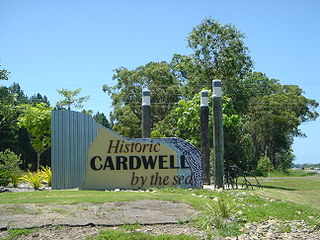
Cardwell is a coastal town and rural locality in the Cassowary Coast Region, Queensland, Australia. In the 2016 census, the locality of Cardwell had a population of 1,309 people.
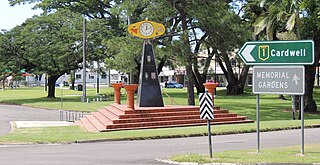
Ingham is a rural town and locality in the Shire of Hinchinbrook, Queensland, Australia. It is named after William Bairstow Ingham and is the administrative centre for the Shire of Hinchinbrook.
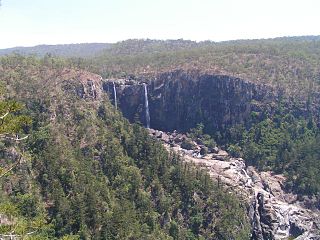
The Herbert River is a river in Far North Queensland, Australia. The southernmost of Queensland's wet tropics river systems, it was named in 1864 by George Elphinstone Dalrymple explorer, after Robert George Wyndham Herbert, the first Premier of Queensland.
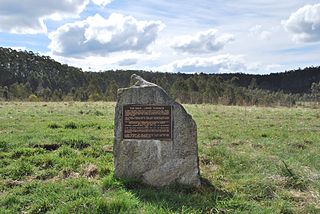
The Yarra Track is the former name of the gold fields road from Healesville to the Woods Point and Jordan Goldfields, in Victoria, Australia.

Mount Spec Road and Little Crystal Creek Bridge is a heritage-listed road from Mutarnee to Paluma with a bridge over Little Crystal Creek at Crystal Creek, City of Townsville, Queensland, Australia. The bridge is 61 kilometres (38 mi) north of Townsville and provides access to the Paluma Range National Park. The road and the bridge were constructed between 1930 and 1936 under the Unemployment Relief Scheme during the Great Depression. They were added to the Queensland Heritage Register on 30 October 2008.

Cardwell Bush Telegraph is a heritage-listed former post office and now heritage centre at 53 Victoria Street, Cardwell, Cassowary Coast Region, Queensland, Australia. The Telegraph and Post Office at Cardwell was designed by Colonial Architect's Office and built in 1870 by George McCallum, making it one of the oldest buildings in North Queensland.

George Augustus Frederick Elphinstone Dalrymple was a colonist, explorer, public servant and politician, member of the Legislative Assembly of Queensland. He founded the towns of Bowen and Cardwell, and pioneered the opening up of the Herbert, Burdekin, Johnstone and Daintree River regions to British colonisation.

Main Range Railway is a heritage-listed railway from the end of Murphys Creek railway station, Murphys Creek to the Ruthven Street overbridge, Harlaxton, Queensland, Australia. It forms part of the Main Line railway and was built from 1865 to 1867 by railway builders Peto, Brassey and Betts. It was added to the Queensland Heritage Register on 5 February 2009.

Tamborine Mountain Road is a continuous 24.1 kilometres (15.0 mi) road route in the Scenic Rim local government area of Queensland, Australia. Part of the route is designated as State Route 95. It is a state-controlled district road, rated as a local road of regional significance (LRRS).

The Sandstone Railway Culvert is a heritage-listed railway culvert at Wulkuraka, City of Ipswich, Queensland, Australia. It was built c. 1865. It was added to the Queensland Heritage Register on 24 June 2005.
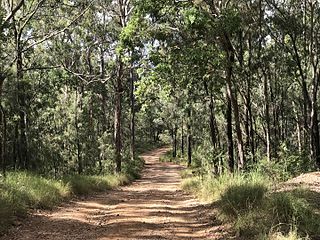
Spicers Gap Road is a heritage-listed road at Spicers Gap Road Conservation Park, Tregony, Southern Downs Region, Queensland, Australia. It was built from 1859 to 1865. It is also known as Spicers Gap Road Conservation Park and Spicers Peak Road. It was added to the Queensland Heritage Register on 23 July 1999.

Suttor River Causeway is a heritage-listed causeway across the Suttor River on the Old Bowen Downs Road, now at St Anns Road, Mount Coolon, Whitsunday Region, Queensland, Australia. It was built in 1876 by the Queensland Department of Public Works. It is also known as St Anns Crossing and Old Bowen Downs Road. It was added to the Queensland Heritage Register on 18 September 2008.

Range Hotel, Burial Ground and Camping Reserve site is a heritage-listed archeological site at Page Road, Hervey Range, City of Townsville, Queensland, Australia. The hotel was built in 1865 to 1866. It was added to the Queensland Heritage Register on 6 March 2009.

Row of Street Trees is a heritage-listed avenue of trees at Macrossan Street, Halifax, Shire of Hinchinbrook, Queensland, Australia. The trees were planted c. 1885. The trees were added to the Queensland Heritage Register on 6 September 2003.
Damper Creek is a coastal locality in the Cassowary Coast Region, Queensland, Australia. In the 2016 census, Damper Creek had a population of 49 people.

Cardwell Divisional Board Hall is a heritage-listed former town hall at 51 Victoria Street, Cardwell, Cassowary Coast Region, Queensland, Australia. It is also known as the Cardwell Shire Chambers, Cardwell Shire Hall, JC Hubinger Memorial Museum, JC Hubinger Museum, and JC Hubinger Memorial Hall. The hall and its World War I honour roll were added to the Queensland Heritage Register on 21 March 2013.
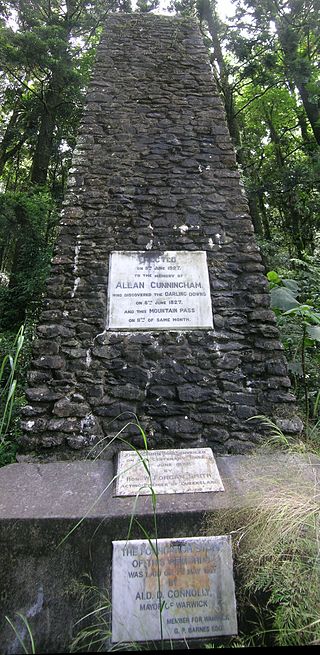
Tregony is a locality in the Southern Downs Region, Queensland, Australia. It is one of the major gateways to the Darling Downs from the Queensland coast. In the 2021 census, Tregony had a population of 36 people.

Hawkins Creek is a rural locality in the Shire of Hinchinbrook, Queensland, Australia. In the 2016 census, Hawkins Creek had a population of 216 people.






















